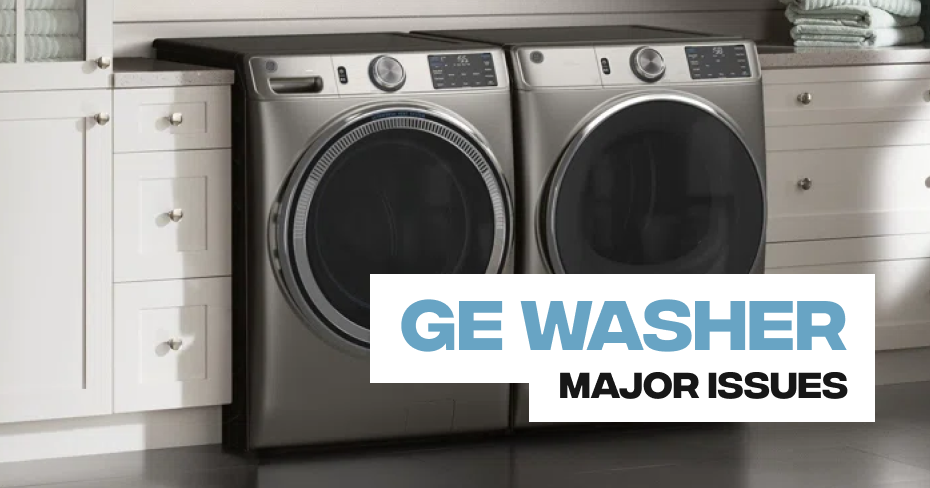
GE Washer Noisy Operation
GE Washing Machine Tub Bearing
The tub bearing is mounted in the middle of the outer tub. The tub bearing helps to keep the inner tub spinning smoothly. Replacing the tub bearing is a very involved repair and will require disassembling most of the washer. If the tub bearing is defective, we recommend replacing both the outer tub and bearing as an assembly if the manufacturer offers the components together.
GE Washing Machine Tub Seal and Bearing Kit
The tub bearing is mounted in the middle of the outer tub. The tub bearing helps to keep the inner tub spinning smoothly. If the washer is noisy during the spin cycle or is leaking from the bottom of the tub near the transmission, the tub seal and bearing are likely defective. Replacing the tub bearing is a very involved repair and will require disassembling most of the washer. If the tub bearing is defective, we recommend replacing the outer tub and bearing at the same time.
GE Washing Machine Rear Drum with Bearing
The rear drum has a bearing or bearings in it to keep the inner tub spinning smoothly. If the tub bearing system is defective the washer can become very noisy. On some machines bearings are sold separately from the rear drum, however we recommend replacing both the outer drum and bearing as an assembly if the manufacturer offers the components together because removing and pressing in the new bearing can be exceptionally difficult. Be aware that replacing the outer tub and bearing is also not easy and can be very costly.
GE Washing Machine Bearing
The tub bearing is mounted in the middle of the outer tub. The tub bearing helps to keep the inner tub spinning smoothly. Replacing the tub bearing is a very involved repair and will require disassembling most of the washer. If the tub bearing is defective, we recommend replacing both the outer tub and bearing.
Improperly balanced load
Confirm the load is balanced. If there are light items and heavy items in the same load the tub will spin out of balance. Wash items with aproximately the same weight together to better balance the load. One or two items will likey shift to one side and cause the tub to go out of balance. You may have to add more items to even out the load.
GE Washing Machine Drive Pulley
The drive pulley might be worn out, cracked, loose or bent. Remove the drive pulley and inspect it carefully. If the drive pulley is damaged or defective, replace it.
GE Washing Machine Shock Absorber
Many front-load washer tubs use shock absorbers to dampen tub movement during operation. If one of the shock absorbers becomes dislodged or breaks, the tub may begin shaking and hitting the sides of the washer cabinet, making a loud noise when the appliance is in the wash or spin cycle. It is recommended to replace all of the shock absorbers at the same time to reduce uneven wear.
GE Washing Machine Suspension Rod
A top-load washer tub is usually supported by four suspension rods. If one of the suspension rods becomes dislodged or breaks, the tub may begin shaking and hitting the sides of the washer cabinet, making a loud noise during operation. Suspension rods will often come in a set of four and it is recommended to replace all four of the rods at the same time to reduce uneven wear.
Foreign objects in the tub or pump
Foreign objects such as coins or safety pins may be in the tub or pump. Inspect the tub for foreign objects that may be rattling around. Most front-load washers have a cleanout to keep items from getting to the pump impeller. Check the cleanout if needed.
GE Washing Machine Motor Coupling
The motor coupling might have failed. The motor coupling connects the motor to the washer transmission. If the washer is overloaded, the motor coupling will fail in order to protect both the motor and transmission. The motor coupling can also fail due to normal wear. Inspect the motor coupling to determine if it is broken. If the motor coupling is broken, replace it.
GE Washing Machine Clutch
The clutch assembly makes the connection between the transmission and the inner tub. It helps the tub to gradually get up to the proper spin speed. As the clutch wears out over time, it may become loud during the spin cycle or just after the spin cycle finishes. The clutch is not repairable—if the clutch is worn out, replace it.
GE Washing Machine Drive Belt
The drive belt might be defective. Over time, the drive belt can dry or burn out and starts to crack. Eventually, a piece of the belt can break off, causing the belt to make a loud noise whenever the motor is running. To determine if the drive belt is broken, inspect the drive belt. If the drive belt is broken or damaged, replace it.
GE Washing Machine Shift Actuator
A shift actuator is the component used on top-load washers to change the tub rotation from agitate to spin. If the washer is making a loud noise during operation, you should inspect the shift actuator for wear, damage, or noise and replace if necessary.
GE Washing Machine Transmission
The washer transmission might be worn out or defective. Transmissions have gears in them that can fail causing the washer to to be noisy during operation. However, this is almost never the case. Before replacing the transmission, first check all of the other more commonly defective parts.
